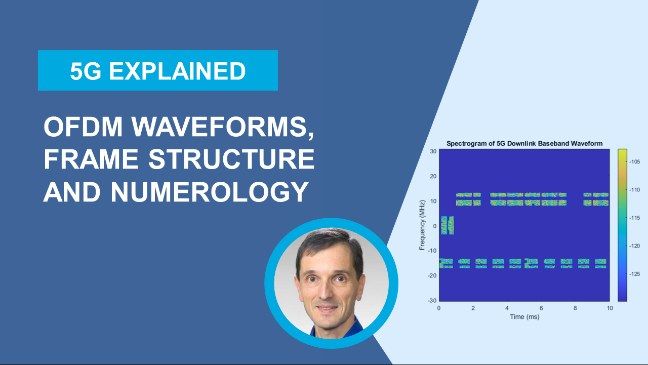5G Explained
The video series explains key concepts behind the 5G New Radio (NR) physical layer standard. You will learn about the requirements and use cases of 5G and the resulting differences between the 5G and LTE standards. Each video offers a deep dive into the technologies and concepts behind 5G NR, including 5G waveforms, frame structure and numerology, downlink and uplink data, Control Resource Sets (CORESETs), demodulation reference symbols (DMRS), synchronization signal blocks (SSB), Cell Search and RACH procedures, and channel estimation.
5G Explained Series Introduction
The video outlines the main goals of the "5G Explained" series and introduces the basic configuration of 5G New Radio.
What is 5G Technology and its Physical Layer (PHY) Specification
Learn about use cases, requirements, some of the main differences between 5G New Radio (NR) and LTE, and deployment scenarios for 5G NR. You’ll also learn about frequency ranges for 5G NR, FR1 and FR2.
5G signals: OFDM waveforms, Frame Structure, and Numerology
Explore the basics behind 5G NR waveforms, frame structure, and numerology. This video also explains how adaptive bandwidth parts help reduce power consumption.
5G NR Physical Downlink Shared Channel (PDSCH)
Learn about downlink data transmission in 5G NR. Explore the downlink shared channel chain, which includes LDPC coding, layer mapping, resource element allocation for PDSCH transmission, PDSCH mapping, and precoding.
5G NR Physical Uplink Shared Channel (PUSCH)
Learn about uplink data transmission in 5G New Radio, which includes elements already found in the downlink shared channel chain including LDPC coding, modulation schemes, layer mapping, the two types of PUSCH mapping, and precoding.
5G NR Downlink Control information (DCI)
Learn about downlink control information (DCI) in 5G New Radio, including its content, encoding, modulation, and mapping to the 5G New Radio slot via the PDCCH or physical downlink control channel.
5G Physical Downlink Control Channel (PDCCH)
Learn about CORESETs, to which the physical downlink control channel (PDCCH) gets mapped. The video illustrates CORESETs and PDCCH using an interactive example and shows how search spaces simplify control information decoding.
5G Physical Uplink Control Channel (PUCCH) and Uplink Control information (UCI)
Learn about uplink control information (UCI) in 5G New Radio, including its content, encoding, modulation, and mapping to the 5G New Radio slot via the PUCCH or physical uplink control channel.
Demodulation Reference Signals (DMRS) in 5G NR
Learn about demodulation reference signals (DMRS) in 5G New Radio, including their use in channel estimation and the different configurations for signal and multi-user MIMO.
Synchronization Signal Blocks (SSB) in 5G New Radio (NR)
Learn about the synchronization signal block (SSB) in 5G New Radio (NR), which is comprised of the primary and secondary synchronization signals and the broadcast channel. You’ll also learn about its role in synchronization.
Physical Broadcast Channel (PBCH) Decoding and 5G Cell Search
Learn about initial acquisition procedures, including cell search based on the synchronization signal block (SSB), extraction of the master information block (MIB), and the random access procedure.
Channel State Information Reference Signal (CSI-RS) and Sounding Reference Signal (SRS)
Learn about the signals in 5G New Radio (NR) that enable channel sounding. Those signals include the channel state information reference signals (CSI-RS) on the downlink and sounding reference signals (SRS) on the uplink.











